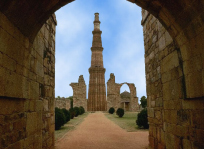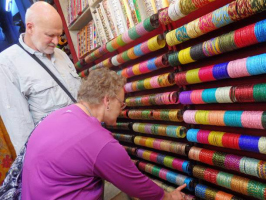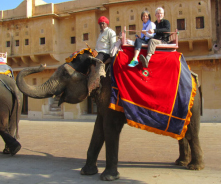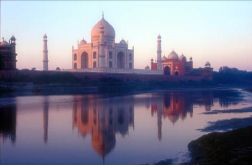Total Days : 12 Days
Tour Destination : Delhi, Jaipur, Fatehpur Sikri, Agra, Gwalior, Orchha, Khajuraho, Varanasi

Namaste! - We welcome you with folded hands
Value Added Optional Tours Available (Request for prices and detailed information): -
Day 01: Arrival / Delhi
Late night arrival. Meeting and assistance upon arrival as our representatives welcome you and escort you to your car.
Whilst the room keys and check-in is organized, our representative would introduce the tour to you and hand over the documents to you.
Welcome to India, or as we say ‘atithi devo bhava’ (the guest is an incarnation of God). Thank you for giving us the opportunity to serve you!
Overnight at Colonels Retreat - Defence Colony, Delhi (Standard Room)
Day 02: Delhi
After breakfast, we proceed on a guided tour of New Delhi, Visiting such sights as, Humayun’s Tomb (1586), the Qutab Minar 72 meters high and one of the most perfect towers in the Persian world. The Iron Pillar which has survived the vagaries of weather for over 1500 years. Continue with a drive through Embassy area, the Government buildings (1921-1930) and Connaught Place, the heart and main shopping district of the capital. We will also visit India Gate.
 Later we cross the city and into the walled gates of the Old city with visits to the Jamma Mosque (1650) and drive through the fabled area of Chandni Chowk (aptly translates to Moonlight Square) where the throngs of shoppers and vendors meet in the oldest area of Delhi. Visit the Raj Ghat and nearby ghats where the founder of the nation, Mahatma Gandhi and thereafter Indira Gandhi and Rajiv Gandhi were cremated.
Later we cross the city and into the walled gates of the Old city with visits to the Jamma Mosque (1650) and drive through the fabled area of Chandni Chowk (aptly translates to Moonlight Square) where the throngs of shoppers and vendors meet in the oldest area of Delhi. Visit the Raj Ghat and nearby ghats where the founder of the nation, Mahatma Gandhi and thereafter Indira Gandhi and Rajiv Gandhi were cremated.
The highlight of this tour would be a ride on cycle rickshaws. Now these are 3-wheel cycles with a sofa seat at the back. The Rickshawalla (Rickshaw driver) sits on a small cushion in the front and two passengers on the sofa seat behind. This is a remarkable way to explore and picture the hustle and bustle as well as the colour of the narrow winding streets bursting with people and pavement shops selling wares of all description - including a laughing set of dentures. The ride would be accompanied by peals of laughter both from the passengers as well as the onlookers.
Overnight at Colonels Retreat - Defence Colony, Delhi (Standard Room)
Day 03: Delhi / Jaipur (310Kms) (06 Hrs Drive)
After breakfast, we will drive to Jaipur along one of the India’s finest freeways
Upon arrival check into Jas Vilas.
 After rest and relaxation, we explore the unending shopping options of Jaipur. An essential starting point for Rajasthan craftwork is block making and block printing and we will be exploring the process from start to finish in some of the popular stores here. The opportunity also exists here to tailor make outfits to your design and size.
After rest and relaxation, we explore the unending shopping options of Jaipur. An essential starting point for Rajasthan craftwork is block making and block printing and we will be exploring the process from start to finish in some of the popular stores here. The opportunity also exists here to tailor make outfits to your design and size.
We also explore one of the chief attractions of Jaipur - its jewelry, which offers a variety that ranges from chunky tribal jewelry to enameled gold to modern diamond jewelry. Kundan (art of stone setting) and enamel jewelry has been a specialty of Rajasthan, particularly that of Jaipur. The stones are embossed into decorative shapes & patterns and embellished with delicate enamel ornamentation in the champeve (raised field) technique. Jaipur is well known for its gold and silver enameling. Colorful bangles made of lac and set with semiprecious stones make an inexpensive buy. The craftsmen take great pains to embed the hundreds of stones into the lac. The skilled gem-cutters of Jaipur carve enchanting little animals and birds from rock, crystal, jade, smoky topaz and amethyst. Intaglio beads & buttons and crystal scent bottles are also available
Overnight at Jas Vilas, Jaipur (Standard Room)
Day 04: Jaipur
This morning we visit Amber Fort, the former capital of the royal Jaipurs. Few fail to be moved by the dramatic Rajput grandeur of this hilltop fortress-palace 11 km north of Jaipur. Set on the dry wrinkled Aravali Hills, and surrounded by fortified battlements, the palace straddles two sepia-hued tundra hills overlooking Maota Lake, and its sprawling crenellated walls lattice the surrounding hills.
We will ride up to this hilltop palace on a Jeep.
 We shall also visit the Hawa Mahal or Palace of the Winds, a five-storied structure of pink sandstone with semi-octagonal and delicately honeycombed windows overlooking the main street of the old city. It was built in 1799 so that veiled royal women could peer down unseen by the world through its 593 stone screens.
We shall also visit the Hawa Mahal or Palace of the Winds, a five-storied structure of pink sandstone with semi-octagonal and delicately honeycombed windows overlooking the main street of the old city. It was built in 1799 so that veiled royal women could peer down unseen by the world through its 593 stone screens.
Afternoon we will visit the City Palace in the heart of the old city is a blend of Rajasthani and Mughal architecture. The palace lies in the heart of the city and occupies the whole central grid. The fortified wall has seven gates and was built for protection from invading armies and animals that lived in jungles, which surrounded the wall that time. Next, we visit the Solar Observatory - an astronomical treasure house, with solar device that give accurate predictions till date.
We also visit the temple of Govind Dev Ji. It is one of the most sacred and famous tourist destinations in India. The temple is located in the City Palace complex, of Jaipur. The idol of Govind Dev Ji is strikingly beautiful for its complete resemblance with Lord Krishna, and the temple is placed between Chandra Mahal and Badal Mahal in the City Palace complex. Every day, various 'Aartis' and 'Prasad' or 'Bhogs' are offered at the temple, at seven different times
Overnight at Jas Vilas, Jaipur (Standard Room)
Day 05: Jaipur / Fatehpur Sikri / Agra (245 Kms) (06 Hrs Drive)
After breakfast we drive to Agra stopping at deserted Capital City of Fatehpur Sikri. This abandoned capital of the Mughals is a perfectly preserved city at the height of the empire’s splendour. The city divided into religious and secular parts has interesting well-sculpted buildings. From here we will continue our drive to Agra.
Upon arrival in Agra, check into Crystal Sarovar.

Evening, we will visit to Mehtab Bagh. The Moonlight Garden was an extension of the Taj Mahal Garden - on the other side of the river. In 1652 Aurangzeb wrote to his father telling of a visit to 'the blessed tomb' and commenting that 'the Mahtab Garden was completely inundated and has lost its charm, but soon it will regain its verdancy. The octagonal pool and the pavilion around it are in splendid condition.' The Mahtab Bagh was lost under the mud but re-excavated in the 1990s. Originally, the garden was planted with fragrant flowers and used in the cool of the night as a place from which to view the Taj Mahal reflected in the octagonal pool and in the river
Overnight at Crystal Sarovar, Agra (Premium Taj View Room)
Day 06: Agra / Gwalior (120 Kms) (02 ½ Hrs Drive)
Agra is the city of the Taj Mahal, perhaps the most photographed monument in the world. However, there is a degree of enigma about the Taj. Once you hear about a building so much and once you see so many pictures of a building your expectations are real high; and this is the enigma about the Taj Mahal. No matter how many pictures you have seen or no matter how high your expectations are the Taj never lets you down - the unparalleled glory and beauty of the building surpasses beyond all human imaginations. At sunrise we visit one of the greatest sights of one’s lifetime - Taj Mahal. A dawn visit to the fabled Taj Mahal to witness the magical effects caused by the reflections of the changing colours of the rising Sun on this brilliant white marble building. Later we return back to our hotel for breakfast.
After breakfast, we ride to the massive Agra Fort. The elegant buildings inside reflect an interesting synthesis of Hindu and Central Asian architectural styles, built by Emperor Akbar, the maze of the courtyards, mosques & private chambers of the fort echo the story of the Mughal Empire.
 Following the tour, we will drive to Gwalior
Following the tour, we will drive to Gwalior
In legend the history of Gwalior goes back to 8 AD when a hermit saint, Gwalipa, cured the chieftain Suraj Sen of leprosy. In a gesture of gratitude the city was founded and named after the saint. An inscription in the fort records that during the 5th century reign of Mihiragula the Hun; a temple of the sun was erected here. Over the centuries, Gwalior has changed hands many times – the Tomar Rajput, Mughal, Afghan and Marathas all ruled here at one time. Later the Scindia Maharajas took and held the fort, and even today the people of Gwalior revere their young Maharaja. The Maharaja of Gwalior was one of the five Maharajas awarded a 21-gun salute by the British, a reward for their loyalty during the Mutiny of 1857. After the Privy Purse was abolished the family played an active role in modern Indian politics.
Upon arrival in Gwalior, check into hotel, Deo Bagh
Gwalior’s main attraction is the colorful fort that has awe-inspiring Jain sculptures, Jain and Hindu temples and the charming sandstone palace. The fort stands on a sandstone precipice 91 m above the surrounding plain. The forts size is impressive, and the first Mughal Emperor Babur described it as “The pearl amongst fortresses of Hind.”
The Jai Vilas Palace is a much more recent structure, designed by Lt Colonel Sir Michael Filose in 1872. It resembles an Italian palazzo in places using painted sandstone to imitate marble. Part of the palace is the residence of the present Maharaja, but 35 rooms house the Scindia Museum, which displays an eccentric collection of royal possessions, curiosities and memorabilia. Of particular note here is the extraordinary Durbar Hall, approached by a crystal staircase. Inside the hall hang two of the world’s largest chandeliers each weighing 3 ½ tons. In keeping with the idiosyncrasies of the Scindia Maharajas, the dining room beneath the Durbar Hall, still displays a battery operated silver train set that transported cigars, dry fruit and drinks around the table after dinner. The Royal Chattris or memorials are dedicated to a Gwalior Maharaja. The lighted images are still clothed and “fed” daily, and it is best to visit here in the early afternoon when the images are shown after their afternoon nap.
Overnight at Deo Bagh, Gwalior (Heritage Royal Room)